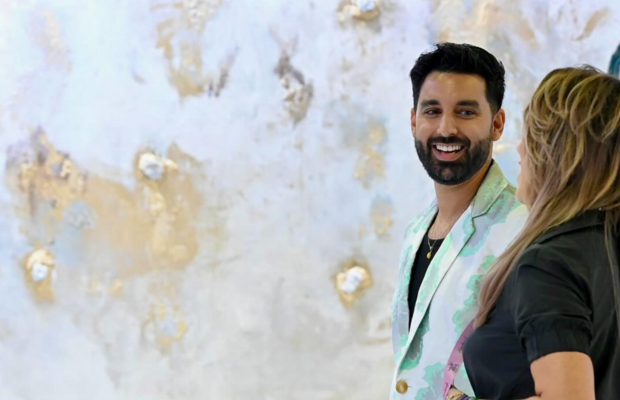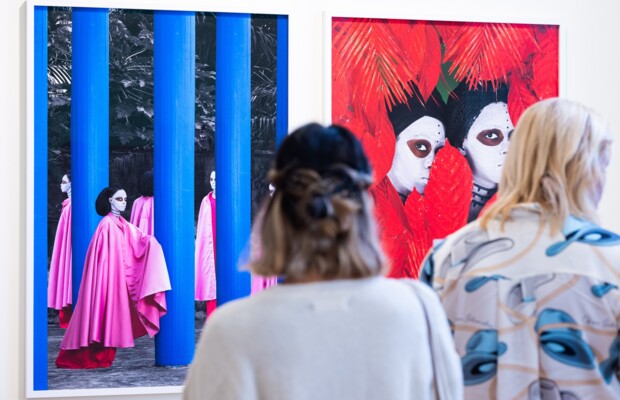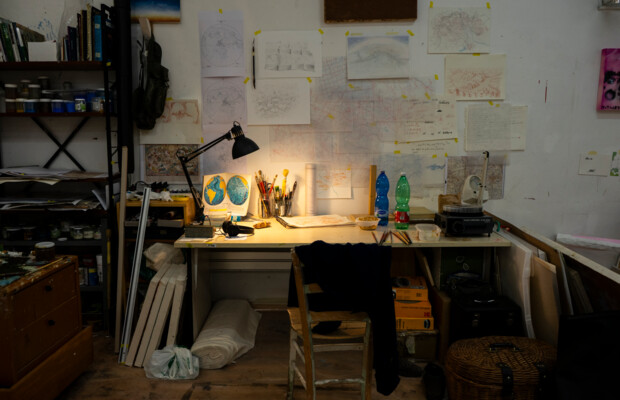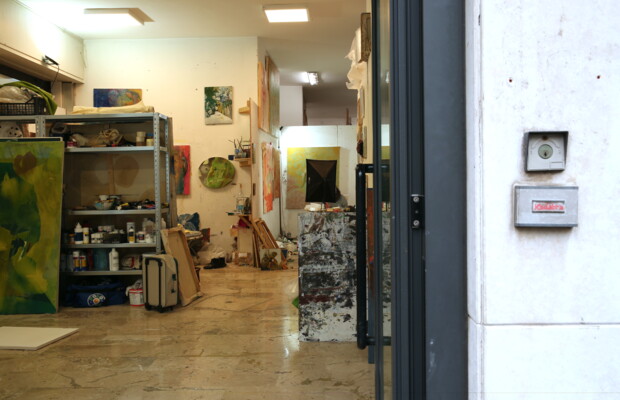Interview with Street Art Curator Auke Wieringa

Street art and graffiti have been getting a lot more attention and credibility since prominent figures like Banksy took the art world by storm. But this hasn’t always been the case. Due to its controversial nature, it has often been shrugged off as vandalism, high illicit group activity and criminality, as claiming public spaces and vehicles is an integral part of the movement. In order to find out more on how this increase in acceptance of street art has affected its market dynamics for art curators, I got in contact with one of the few street art curators in Amsterdam for an interview.
Auke Wieringa is a graphic designer, art collector, and curator specializing in graffiti and post-graffiti/street art. He graduated from the Rietveld Art Academie Amsterdam in 2001 and since then pursued digital content design as his main profession. However, he has always had a special love for graffiti. Not only does he love collecting post graffiti artworks from artists all around the world, but he immersed himself in street art during his teenage years back in his hometown, Leiden. Since then, many things have changed. Instead of going out in the streets and “bombing” himself, he decided to be active in the community in a different way, by supporting fellow street artists, providing an online platform for them to exhibit their work. What once was just a hobby and a playful passion has now become a dream job as he launched his online gallery where people could purchase pieces from his collection. These vary from silk screen prints to simple prints and more abstract works with spray paint that can be considered as post-graffiti. Among his collections, buyers can find a large variety of international street artists and graffiti writers from Berlin street art collective 1UP and OBEY to individual artists Jason Revok, Ces 53, Seen and more. The topic seemed really exciting to me, so I couldn’t wait to talk to Auke in person and find out more about the inner workings of street art curating.
The day of the interview arrives and we meet up at his studio to get talking. We discuss everything from his background as a curator and collector to his personal relationship to graffiti and I quickly realize that his engagement in the street art scene is fueled by pure passion rather than entrepreneurship. I find this perspective very invigorating, as the curatorial field sometimes carries an air of intellectual elitism, which can at times disconnect the curatorial practice from broader audiences. Within the street art and graffiti scene, the core values and motivations seem to be less fueled by intellectualism but rather by emotionalism; The sheer joy and love for graffiti art itself, and the lifestyle that comes with it.
“Purchasing new art pieces has become sort of an obsession” he says, gesturing to his collection of post-graffiti art pieces he keeps in his private studio. His display is a mix between post-graffiti artworks of artist-friends he likes and other pieces that he finds at exhibitions around the Netherlands that fit his style.
Street art and graffiti have been getting a lot more attention and credibility since prominent figures like Banksy took the art world by storm. But this hasn’t always been the case. Due to its controversial nature, it has often been shrugged off as vandalism, high illicit group activity and criminality, as claiming public spaces and vehicles is an integral part of the movement. In order to find out more on how this increase in acceptance of street art has affected its market dynamics for art curators, I got in contact with one of the few street art curators in Amsterdam for an interview.

Graffiti isn’t necessarily a political statement, it’s more of an individual statement saying, “look, I exist too. I don’t have any chances in the commercial world but I exist on the street.” This is what graffiti is at its core.
P: How did your career as an art collector and curator start out?
A: It wasn’t something i planned, i just grew up being very much in the dutch graffiti scene, i’ve been active in it since 1989 and i know pretty much everyone there in person. Many of them are friends. I’ve seen their development starting from being underground graffiti writers, spraying on trains and doing wall murals, to moving to post-graffiti and street art. Actually, I don't like the word street art, it's more post-graffiti. The way I curate is partly by being in contact with many artists from the graffiti scene I personally know but also by looking at public art collections around the Netherlands and on the internet. I also see it as a big hobby or addiction. I always see work and then I think ‘Oh wow, i gotta have it and then i buy it’. That’s kind of how I began my online gallery, with the aim of selling the art I purchased again.
P: What exactly is post-graffiti then? And how come graffiti has become so famous in the past few decades, when at the beginning it was so frowned upon?
A: I think Banksy had a big part in this. He made it more socially accepted and respected in polite society. That really helped. People pay millions of dollars for a Banksy artwork and he’s frequently exhibited in most renowned museums worldwide. And there is definitely a difference between graffiti and post-graffiti in my opinion. Post-graffiti is taken one step further, things have become more abstract. Where graffiti is a form of writing, post-graffiti most of the time doesn’t necessarily use letters. Also, it’s like graffiti on a canvas, and oftentimes the genre works with abstract forms that resemble graffiti, but doesn’t adhere to its more strict requirements. It’s more transgressional. It also takes more effort and creativity to make post-graffiti. It takes more from a person since it doesn’t have strict rules and only uses the associated aesthetics of the graffiti scene.
P: What are your aspirations for your career in the arts?
A: I would love to graduate from being an independent curator of an online gallery to owning a physical gallery somewhere in Amsterdam. Realistically, I would like to rent out a space somewhere in the center for a few weeks and do an opening of a pop-up store with my collection.
P: How do you perceive the value of networking within the art field?
A: The funny thing is, I don't necessarily see networking the same way as others might, in the graffiti scene you network by just hanging out with the writers. You meet up to paint and that's how you get in contact with the artists, since graffiti is a community based art practice. You know each other from the street. Sometimes you see each other at an opening. It varies.
A big part of street art is community engagement, which is why it’s so important to have a network of artists and collectives that you are close with. This is how you help each other out.


P: So would you say that in order to curate street art it helps being in the scene yourself, as a curator?
A: Depending on what sub-scene of art you work in. For street art it works really well when you’re part of the scene because you’re one of the guys, you’re not seen as a higher-up person who has a lot of money and wants to buy art. But also in general, I think if you’re trying to get a hold of big artists, it’s always best to have a large network of people you know in the art world.
P: So who are your customers?
A: I’m not quite sure because I never actually see the buyers in person. It all goes via the internet. However, I can see that people all around the world buy art pieces from my gallery, not only Dutch customers. That is because some artists' works that I exhibit online have their fanbase in specific countries such as Italy, Germany or the UK.
P: What challenges do you encounter in your profession?
A: If you want to have a physical gallery in Amsterdam, you risk getting into financial issues, especially as an independent curator. There are only a few physical street art galleries in Amsterdam but two of them for example are closing soon because of the rents that are rising immensely. This is a big problem in Amsterdam. The rents are just astronomical. If you have a good location they can easily triple the rent cost and kick you out, if you are not willing/able to pay, and then they will take in a new establishment that can pay the price. The whole cultural scene of Amsterdam is dying because of this. The alternative then is either to go out of the city but then you don’t have any customers anymore, so i think that's why online galleries are gaining more and more popularity.
P: How do you establish connections with curators?
A: I don’t necessarily go out of my way to connect with other curators for the sake of business, it's more based on whether I get along with them or if it’s curators who also specialize in street art, which are most of the time already in the broad community network that graffiti creates. I have a friend who also curates but I know him from the graffiti scene because there the lines between curator, artist, and buyers kind of merge together. The roles aren’t that sharply seperated.
P: What role do you believe online tools play in promoting yourself and your work?
A: I work with SEO (Search Engine Optimisation), sometimes it works and sometimes it doesn’t. If you look for graffiti street art in Amsterdam, then my website is on top of the search outcomes. Otherwise, I use instagram to promote my online gallery, which also helps because of the algorithm. Overall, I would say that since I don't know the largest number of my customers in person, the search engine optimization online tool helps a lot in promoting my work.
The interview with Auke really opened up my horizon in terms of artist representation in the curator space. I learned that the art world has its place beyond its preconceived elitist circles thanks to curators like Auke who make way for the free spirited, controversial art practice of street art within the art market. The lines between curating and friendship might blur, however this is merely a symptom of the street art culture itself, whose core value is to be a community in which everybody is equal.
Share the post:












